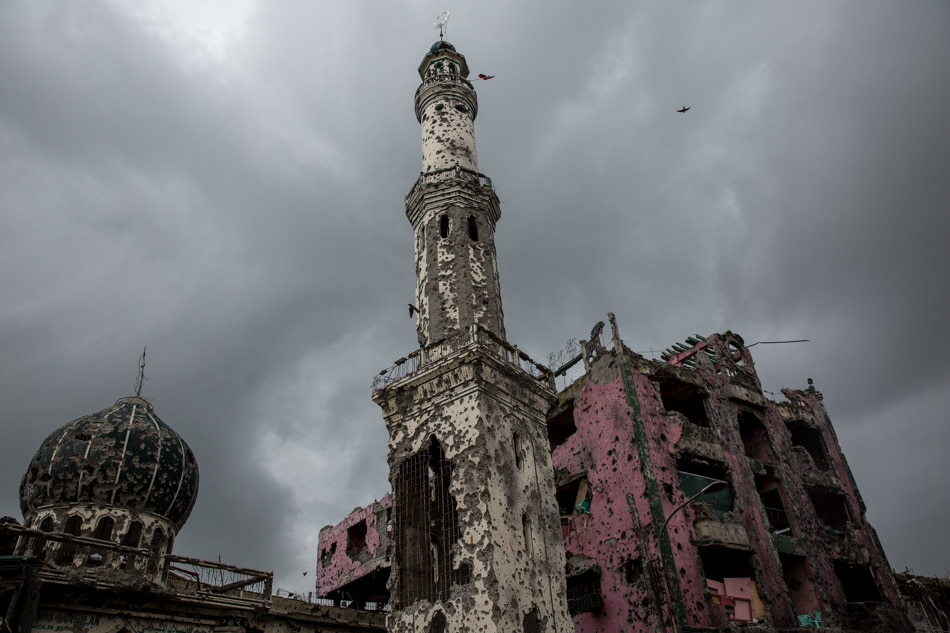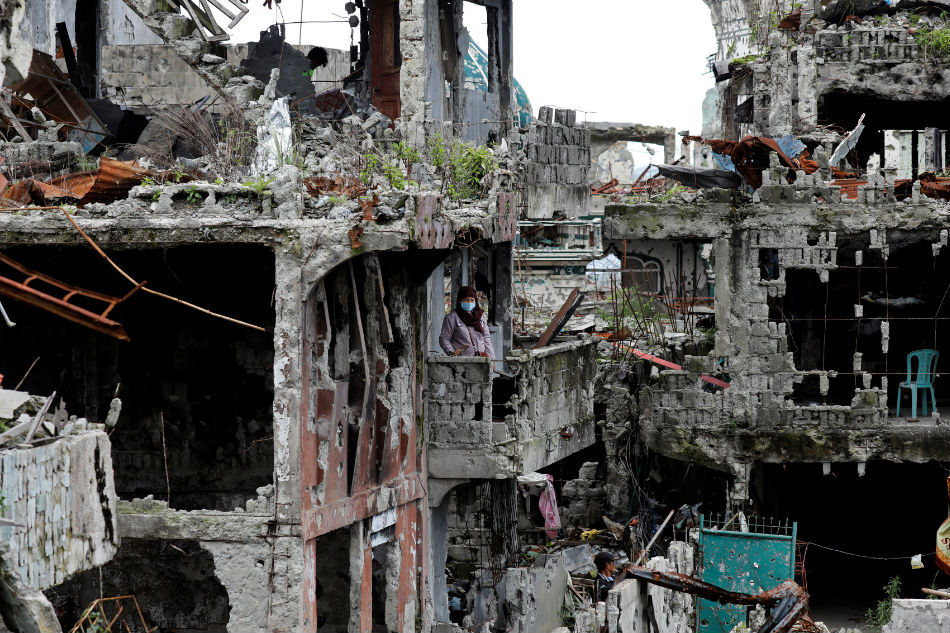Emotions run high as Marawi residents visit war-shattered homes | ABS-CBN

Welcome, Kapamilya! We use cookies to improve your browsing experience. Continuing to use this site means you agree to our use of cookies. Tell me more!
Emotions run high as Marawi residents visit war-shattered homes
Emotions run high as Marawi residents visit war-shattered homes
Ronron Calunsod,
Kyodo News
Published May 16, 2018 09:27 AM PHT
MARAWI CITY - "I've been here for 40 years, and this is one of the oldest gasolines stations in the city."
MARAWI CITY - "I've been here for 40 years, and this is one of the oldest gasolines stations in the city."
On a sunny morning in April, Paisal Rasuman, 72, briefly orients this reporter to his properties along Alauya Alonto Street in the southern Philippine city of Marawi.
On a sunny morning in April, Paisal Rasuman, 72, briefly orients this reporter to his properties along Alauya Alonto Street in the southern Philippine city of Marawi.
Accompanied by his wife and eldest son, the businessman points to his house, then to a commercial building just across the street, and then to a gasoline station across the next street.
Accompanied by his wife and eldest son, the businessman points to his house, then to a commercial building just across the street, and then to a gasoline station across the next street.
Just like the rest of the houses, establishments, schools and other buildings in the immediate surroundings, Rasuman's properties are now just remnants of what used to be a lively community in the city's Moncado Kadingilan neighborhood.
Just like the rest of the houses, establishments, schools and other buildings in the immediate surroundings, Rasuman's properties are now just remnants of what used to be a lively community in the city's Moncado Kadingilan neighborhood.
ADVERTISEMENT
The area lies in the periphery of the Battle for Marawi's Ground Zero after Islamic State-inspired militants from the local Maute Group and Abu Sayyaf Group stormed the predominantly Muslim city on May 23 last year.
The area lies in the periphery of the Battle for Marawi's Ground Zero after Islamic State-inspired militants from the local Maute Group and Abu Sayyaf Group stormed the predominantly Muslim city on May 23 last year.
Since the siege ended in October, Rasuman and his family had been unable to personally check on their properties, but authorities have now allowed residents of the main battle area to temporary visit and retrieve any belongings that remain.
Since the siege ended in October, Rasuman and his family had been unable to personally check on their properties, but authorities have now allowed residents of the main battle area to temporary visit and retrieve any belongings that remain.
The 250-hectare area, covering 24 out of Marawi's 96 neighborhoods, has been divided into nine clusters, each of which could be visited for only three days between April 1 and May 10.
The 250-hectare area, covering 24 out of Marawi's 96 neighborhoods, has been divided into nine clusters, each of which could be visited for only three days between April 1 and May 10.
According to Felix Castro, a field officer of the Marawi rebuilding agency, more than 26,800 families used to live there prior to the siege.
According to Felix Castro, a field officer of the Marawi rebuilding agency, more than 26,800 families used to live there prior to the siege.
When this reporter chanced upon Rasuman beside his war-ravaged house, the father of three and grandfather to many turned emotional when asked how it was for him seeing it for the first time.
When this reporter chanced upon Rasuman beside his war-ravaged house, the father of three and grandfather to many turned emotional when asked how it was for him seeing it for the first time.
ADVERTISEMENT
"I was really...," Rasuman said, failing to complete his remarks and struggling to maintain his composure. Surveying his home, he could only follow through with, "Imagine..."
"I was really...," Rasuman said, failing to complete his remarks and struggling to maintain his composure. Surveying his home, he could only follow through with, "Imagine..."
Some 20 meters away, Omar and Norhana Ashar were looking at bullet-ridden bare walls of what used to be the couple's two-story residence, inherited from Omar's parents.
Some 20 meters away, Omar and Norhana Ashar were looking at bullet-ridden bare walls of what used to be the couple's two-story residence, inherited from Omar's parents.
Already roofless, what was left in their abode was a bed frame, contorted and apparently set on fire. "I was actually born in this house," Omar, 31, said. "Our four children grew up here," added Norhana, 32.
Already roofless, what was left in their abode was a bed frame, contorted and apparently set on fire. "I was actually born in this house," Omar, 31, said. "Our four children grew up here," added Norhana, 32.
When the couple first saw their house two days earlier, Norhana said she cried so hard that she almost fainted.
When the couple first saw their house two days earlier, Norhana said she cried so hard that she almost fainted.
They fled the city in May last year with hardly any of their valued possessions, including what they were selling at their store nearby, which was their main source of income. "I even left some gold jewelry here," Norhana lamented.
They fled the city in May last year with hardly any of their valued possessions, including what they were selling at their store nearby, which was their main source of income. "I even left some gold jewelry here," Norhana lamented.
ADVERTISEMENT
Taking another look at their house -- what remains of it -- Norhana's sadness was apparent. "I don't know what they did to our house. It looks like it was burned indeed," she said, her voice cracking and her eyes welling up.
Taking another look at their house -- what remains of it -- Norhana's sadness was apparent. "I don't know what they did to our house. It looks like it was burned indeed," she said, her voice cracking and her eyes welling up.
Unlike the residents of the 72 other neighborhoods who have mostly returned home, residents of the main battle area are still barred because "the place is really not totally safe for all to come in," specifically due to unrecovered explosives, said Eduardo del Rosario, overall chairman of the rebuilding task force.
Unlike the residents of the 72 other neighborhoods who have mostly returned home, residents of the main battle area are still barred because "the place is really not totally safe for all to come in," specifically due to unrecovered explosives, said Eduardo del Rosario, overall chairman of the rebuilding task force.
The government is negotiating with a Chinese-led consortium to rebuild the most-affected area and make it far better than before -- from debris management to provision of underground utilities such as water, power and telecommunications, with a centralized drainage system and a sewage treatment plant, among others.
The government is negotiating with a Chinese-led consortium to rebuild the most-affected area and make it far better than before -- from debris management to provision of underground utilities such as water, power and telecommunications, with a centralized drainage system and a sewage treatment plant, among others.
It wants the consortium to build community halls, Islamic schools, public schools, a convention center, a memorial site, port facilities, a transport hub, parks, and a central market in what would become Marawi's central business district.
It wants the consortium to build community halls, Islamic schools, public schools, a convention center, a memorial site, port facilities, a transport hub, parks, and a central market in what would become Marawi's central business district.
The consortium's proposal entails a cost of 17.2 billion Philippine pesos (nearly $329 million), and remains under consultation with local stakeholders. The government hopes groundbreaking for the area's development will be held on June 7, and eyes completion of the entire project by the last quarter of 2021.
The consortium's proposal entails a cost of 17.2 billion Philippine pesos (nearly $329 million), and remains under consultation with local stakeholders. The government hopes groundbreaking for the area's development will be held on June 7, and eyes completion of the entire project by the last quarter of 2021.
ADVERTISEMENT
According to the rebuilding agency, no private land in the most-affected area will be forcibly taken. And as soon as the clearing and development is done, all its former residents will be allowed to return and manage their properties.
According to the rebuilding agency, no private land in the most-affected area will be forcibly taken. And as soon as the clearing and development is done, all its former residents will be allowed to return and manage their properties.
Rasuman, who has been living alternately in the capital Manila and Cagayan de Oro City northeast of Marawi, hopes the government will pay him if it decides to take over his properties for the area's massive development.
Rasuman, who has been living alternately in the capital Manila and Cagayan de Oro City northeast of Marawi, hopes the government will pay him if it decides to take over his properties for the area's massive development.
"With my age, these are really for my children," he said.
"With my age, these are really for my children," he said.
Having seen the development plans for the most affected area, Rasuman beams with hope in "having a new Marawi if that will materialize," saying, "I have a very big trust on the president. I have very high confidence (in him)."
Having seen the development plans for the most affected area, Rasuman beams with hope in "having a new Marawi if that will materialize," saying, "I have a very big trust on the president. I have very high confidence (in him)."
President Rodrigo Duterte, who ordered an all-out offensive against Marawi's militants through October last year and declared martial law in the entire Mindanao, vowed to rebuild a much better Marawi.
President Rodrigo Duterte, who ordered an all-out offensive against Marawi's militants through October last year and declared martial law in the entire Mindanao, vowed to rebuild a much better Marawi.
ADVERTISEMENT
The Ashars, meanwhile, who are staying with relatives in another municipality, were still unaware about the development plans in their community and said they visited just to see their house "since we may not be able to return after a number of years."
The Ashars, meanwhile, who are staying with relatives in another municipality, were still unaware about the development plans in their community and said they visited just to see their house "since we may not be able to return after a number of years."
The couple recalled the fear they felt when the siege began and the militants ordered them to close shop, while attempting to recruit them. They also lamented how their lives were disrupted by the siege, especially the schooling of their children.
The couple recalled the fear they felt when the siege began and the militants ordered them to close shop, while attempting to recruit them. They also lamented how their lives were disrupted by the siege, especially the schooling of their children.
Although confident that the city is now safe from the militants, Norhana warned, "If they do it again, we ourselves will strike back."
Although confident that the city is now safe from the militants, Norhana warned, "If they do it again, we ourselves will strike back."
With the death of nearly 1,000 militants, including their key leaders, Rasuman thinks the terror groups "are finished."
With the death of nearly 1,000 militants, including their key leaders, Rasuman thinks the terror groups "are finished."
"Nobody will support the Maute here. Look at what happened to our properties," he said.
"Nobody will support the Maute here. Look at what happened to our properties," he said.
==Kyodo
ADVERTISEMENT
ADVERTISEMENT



